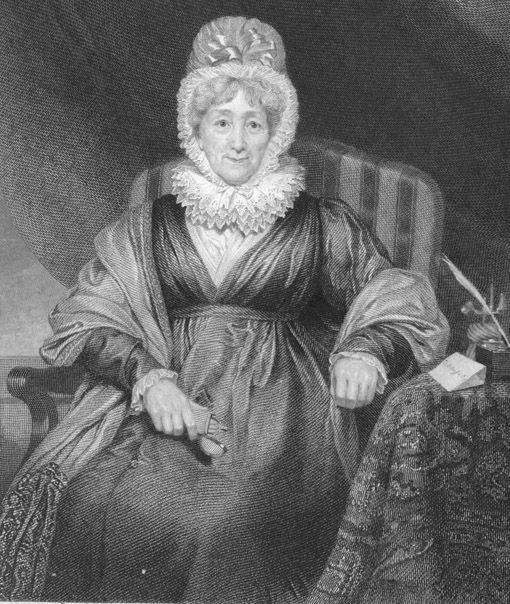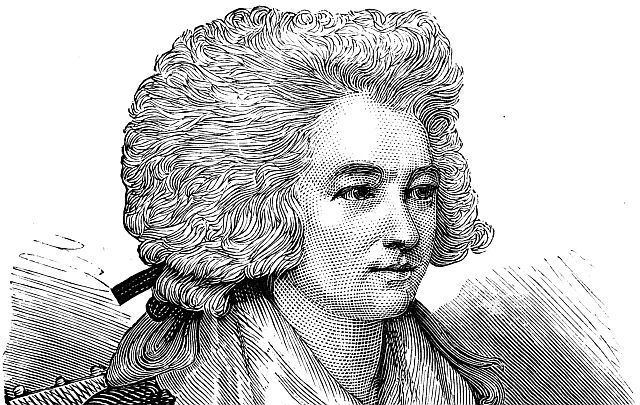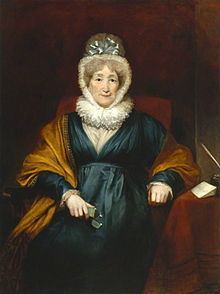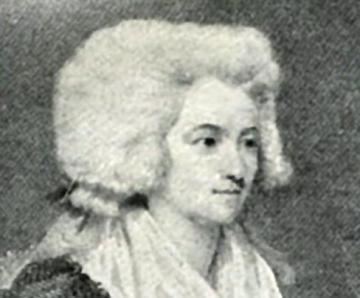Nationality English Name Hannah More | Role Writer | |
 | ||
Residence BristolLondonWrington Occupation PoetPlaywrightAuthorEducator Known for PoetryDramaPhilanthropy Books Coelebs in Search of a Wife, Strictures on the modern s, The shepherd of Salisbu, Essays on Various Subjects, The works of Hannah More Similar People | ||
Hannah more promo 2015 full length feature film coming soon
Hannah More (2 February 1745 – 7 September 1833) was an English religious writer and philanthropist, remembered as a poet and playwright in the circle of Johnson, Reynolds and Garrick, as a writer on moral and religious subjects, and as a practical philanthropist. Born in Bristol she taught at a school established by her father and began writing plays. She became involved with the literary elite in London as a leading member of the Bluestocking group. Her plays and poetry became more evangelical and she joined a group of campaigners against the slave trade. In the 1790s she wrote several Cheap Repository Tracts on moral, religious and political topics, for distribution to the literate poor. Meanwhile she did increasing philanthropic work in the Mendip area, encouraged by William Wilberforce.
Contents
- Hannah more promo 2015 full length feature film coming soon
- Hannah more self love christian audio book
- Early life
- Playwright
- Evangelical moralist
- Philanthropist
- Legacy
- Archives
- References

Hannah more self love christian audio book
Early life

Born in 1745 at Fishponds in the parish of Stapleton, near Bristol, Hannah More was the fourth of five daughters of Jacob More (1700-1783), a schoolmaster originally from Harleston, Norfolk. He was from a strong Presbyterian family in Norfolk, but had become a member of the Church of England, and originally intended to pursue a career in the Church, but after the disappointment of losing a lawsuit over an estate he had hoped to inherit, he moved to Bristol, where he became an excise officer and was later appointed teacher at the Fishponds free school.

They were a close family and the sisters were first educated by their father, learning Latin and mathematics: Hannah was also taught by her elder sisters, through whom she learned French. Her conversational French was improved by spending time with French prisoners of war in Frenchay during the Seven Years' War. She was keen to learn, and possessed a sharp intellect - she was assiduous in studying and, according to family tradition, began writing at an early age.

In 1758 Jacob established his own girls' boarding school at Trinity Street in Bristol for the elder sisters, Mary and Elizabeth to run, while he and his wife moved to Stony Hill in the city to open a school for boys. Hannah More became a pupil when she was twelve years old, and taught at the school in her early adulthood.

In 1767 More gave up her share in the school after becoming engaged to William Turner of Tyntesfield, Wraxall, Somerset, whom she had met when he began teaching her cousins. After six years the wedding had not taken place and Turner seemed reluctant to name a date, and in 1773 the engagement was broken off; it seems that, as a consequence, More suffered a nervous breakdown and spent some time in Uphill, near Weston-super-Mare, recuperating. As compensation, Hannah More was induced to accept a £200 annuity from Turner. This set her free for literary pursuits, and in the winter of 1773–74 she went to London in the company of her sisters, Sarah and Martha – the first of many such trips she made at yearly intervals. Some verses that she had written on David Garrick's version of King Lear led to an acquaintance with the celebrated actor and playwright.
Playwright
Hannah More's first literary efforts were pastoral plays, written while she was teaching at the school and suitable for young ladies to act, the first being written in 1762 under the title of The Search after Happiness; by the mid-1780s over 10,000 copies had been sold. Metastasio was one of her literary models; on his opera of Attilio Regulo she based a drama, The Inflexible Captive.
More attempted to associate herself with London's literary elite, including Samuel Johnson, Joshua Reynolds and Edmund Burke. Johnson is quoted as saying to her "Madam, before you flatter a man so grossly to his face, you should consider whether or not your flattery is worth having." He would later be quoted as calling her "the finest versifatrix in the English language". She also became one of the prominent members of the Bluestocking group of women engaged in polite conversation and literary and intellectual pursuits, attending the salon of Elizabeth Montagu, where she also met and became acquainted with Frances Boscawen, Elizabeth Carter, Elizabeth Vesey and Hester Chapone, some of whom were to become lifelong friends. She later wrote a witty celebration of her friends and the circle to which they belonged in her 1782 poem The Bas Bleu, or, Conversation, published in 1784.
Garrick wrote the prologue and epilogue for Hannah More's tragedy Percy, which was acted with great success at Covent Garden in December 1777. Percy was revived in 1785 with Sarah Siddons at Theatre Royal, Drury Lane. A copy of Percy was found amongst Mozart's possessions in 1791. Another drama, The Fatal Falsehood, produced in 1779 after Garrick's death, was less successful and, as a consequence of its failure, she never wrote for the stage again. However a tragedy entitled "The Inflexible Captive" was published in 1818. In 1781 she first met Horace Walpole, man of letters and art historian, and corresponded with him from that time. At Bristol she discovered the poet Ann Yearsley and, when Yearsley became destitute, raised a considerable sum of money for her benefit. Lactilia, as Yearsley was called, published Poems, on Several Occasions in 1785, earning about £600. More and Montagu held the profits in trust to protect them from Yearsley's husband: Ann Yearsley wished to receive the capital, and made insinuations of stealing against More, forcing her to release the money. These literary and social failures caused More's withdrawal from London's intellectual circles.
Evangelical moralist
In the 1780s Hannah More became a friend of James Oglethorpe, who had long been concerned with slavery as a moral issue and who was working with Granville Sharp in an early abolitionist capacity. More published Sacred Dramas in 1782 and it rapidly ran through nineteen editions. These and the poems Bas-Bleu and Florio (1786) mark her gradual transition to more serious views of life, which were fully expressed in prose, in her Thoughts on the Importance of the Manners of the Great to General Society (1788), and An Estimate of the Religion of the Fashionable World (1790). By this point she was intimate with William Wilberforce and Zachary Macaulay, with whose evangelical views she was in sympathy. She published a poem on Slavery in 1788, and was for many years a friend of Beilby Porteus, Bishop of London and a leading abolitionist, who drew her into the group of prominent campaigners against the slave trade such as Wilberforce, Charles Middleton and James Ramsay, based at Teston, Kent.
In 1785 she bought a house, at Cowslip Green, near Wrington, in northern Somerset, where she settled down to country life with her sister Martha, and wrote many ethical books and tracts: Strictures on the Modern System of Female Education (1799), Hints towards Forming the Character of a Young Princess (1805), Coelebs in Search of a Wife (only nominally a story, 1809), Practical Piety (1811), Christian Morals (1813), Character of St Paul (1815), Moral Sketches (1819). She was a rapid writer, and her work is consequently discursive, animated and formless. The originality and force of More's writings perhaps explains her extraordinary popularity. At the behest of Porteus, she wrote many spirited rhymes and prose tales, the earliest of which was Village Politics, by Will Chip (1792), intended to counteract the doctrines of Thomas Paine and the influence of the French Revolution. More became a prominent opponent of the slave trade in the late 18th century.
The success of Village Politics induced More and Porteus to begin the series of Cheap Repository Tracts, which from 1795 to 1797 were produced at the rate of three a month. Perhaps the most famous of these is The Shepherd of Salisbury Plain, describing a family of phenomenal frugality and contentment. This was translated into several languages. Two million copies of these rapid and telling sketches were circulated, in one year, teaching the poor in rhetoric of most ingenious homeliness to rely upon the virtues of content, sobriety, humility, industry, reverence for the British Constitution, hatred of the French, trust in God and in the kindness of the gentry.
She was shocked by strides for female education in France, saying "they run to study philosophy, and neglect their families to be present at lectures in anatomy".
Philanthropist
In 1785 Hannah More moved to a cottage in rural Somerset, "to escape from the world gradually". The school at Wedmore received strong opposition from the locals, who petitioned the Dean of Wells to remove her.
John Scandrett Harford of Blaise Castle was a prodigious benefactor to More's schools in the 1790s, and More modeled the idealised hero and heroine in Coelebs in Search of Wife (1809) on Mr and Mrs Harford. She refused to read Mary Wollstonecraft's Rights of Women, saying "so many women are fond of government... because they are not fit for it. To be unstable and capricious is but too characteristic of our sex".
In 1816, More is quoted as saying that 'peace with France [is] ... a worse evil than war' following the Battle of Waterloo, and refused to allow a French translation of Coelebs. She turned down an honorary membership of the Royal Society of Literature because she considered her "sex alone a disqualification".
In the late-1780s Hannah and Martha More conducted philanthropic work in the Mendip area, following encouragement by Wilberforce, who saw the poor conditions of the locals when he visited Cheddar in 1789. She was instrumental in setting up twelve schools by 1800 where reading, the Bible and the catechism were taught to local children. More also donated money to Bishop Philander Chase for the founding of Kenyon College, and a portrait of her hangs there in Peirce Hall.
The More sisters met with a good deal of opposition in their works: the farmers thought that education, even to the limited extent of learning to read, would be fatal to agriculture, and the clergy, whose neglect she was making good, accused her of Methodist tendencies. In her old age, philanthropists from all parts made pilgrimages to see the bright and amiable old lady, and she retained all her faculties until within two years of her death. She spent the last five years of her life in Clifton, and died on 7 September 1833. She is buried at Church of All Saints, Wrington., a bust of her and John Locke exist in the south porch.
Legacy
Several local schools and the Hannah More Academy at Reisterstown, Maryland are named in her honour. Hannah More Primary School was built in Old Market, Bristol in the 1840s. An image of More was used in 2012 on the Bristol Pound local currency. In Wrington 'Hannah More Close' is named after her.
More's reputation was not always positive - Augustine Birrell in his 1906 work Hannah More Once More admits burying all 19 volumes of her work in his garden in disgust.
Archives
Letters to, from and about Hannah More are held by Bristol Archives, including one from William Wilberforce (Ref. 28048/C/1/2) (online catalogue).
Larger collections of records relating to Hannah More can also be found at the British Library, Manuscript Collections, Longleat, Newport Central Library, Bodleian Library, Cambridge University: St John's College Library, Victoria and Albert Museum, Bristol Reference Library, Cambridge University Library, The Women's Library, Gloucestershire Archives, and National Museums Liverpool: Maritime Archives and Library.
